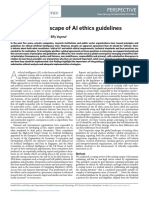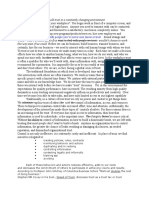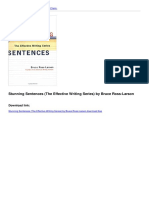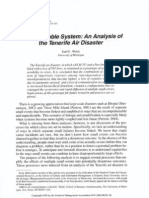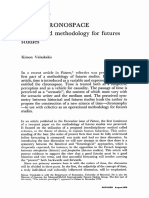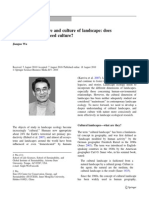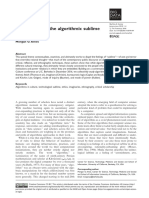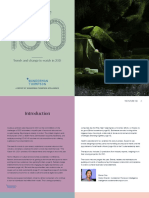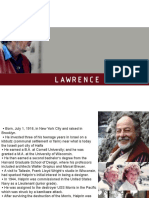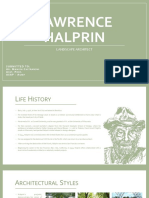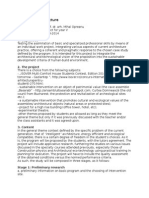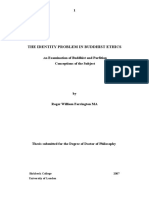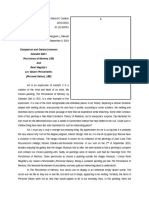Lawrence Halprin
From Wikipedia, the free encyclopedia
Ira Keller Fountain, Portland, Oregon
Lawrence Halprin (July 1, 1916 - October 25, 2009) was an influential American landscape
architect, designer and teacher.[1]
Beginning his career in the San Francisco Bay Area, California, in 1949, Halprin often collaborated
with a local circle of modernist architects on relatively modest projects. These figures
included William Wurster, Joseph Esherick, Vernon DeMars, Mario J. Ciampi, and others
associated with UC Berkeley. Gradually accumulating a regional reputation in the northwest,
Halprin first came to national attention with his work at the 1962 Seattle World's Fair,
the Ghirardelli Square adaptive-reuse project in San Francisco, and the landmark pedestrian street
/ transit mall Nicollet Mall in Minneapolis. Halprin's career proved influential to an entire generation
in his specific design solutions, his emphasis on user experience to develop those solutions, and
his collaborative design process.
Halprin's point-of-view and practice are summarized in his definition of modernism:
"To be properly understood, Modernism is not just a matter of cubist space but of a whole
appreciation of environmental design as a holistic approach to the matter of making
spaces for people to live.... Modernism, as I define it and practice it, includes and is based
on the vital archetypal needs of human being as individuals as well as social groups." [2]
In his best work, he construed landscape architecture as narrative. [3]
Contents
[hide]
1 Early life
2 Career
3 Projects
4 Awards
5 Publications
6 Notes
7 References
8 External links
Early life[edit]
Freeway Park, Seattle
Halprin grew up in Brooklyn, New York; and as a schoolboy, he earned acclaim playing
sandlot baseball. He also invested three of his teenage years in Palestine on a kibbutz near
what is today the Israeli port city of Haifa.[4] The Heritage Park Plaza in Fort Worth, Texas,
designed by Halprin and built in 1980, was listed on the National Register of Historic
Places as its featured listing of the week, on May 21, 2010.
He earned a B.A. at Cornell University; and he was granted a M.A. at the University of
Wisconsin. Then he earned a second bachelors degree from the Harvard Graduate School of
Design, where his professors included architects Walter Gropius and Marcel Breuer.[5] His
Harvard classmates included Philip Johnson and I.M. Pei. A visit to Taliesin, Frank Lloyd
Wrights studio in Wisconsin, had sparked Halprins initial interest in being a designer; [4] and
his formal training began in classes with Christopher Tunnard.
In 1944, Halprin was commissioned in the United States Navy as a Lieutenant (junior grade).
He was assigned to the destroyer USSMorris in the Pacific which was struck by
a kamikaze attack. After surviving the destruction of the Morris, Halprin was sent to San
Francisco on leave. It was there he would stay following his discharge.
Career[edit]
�Lovejoy Fountain Park, Portland, Oregon
After discharge from military service, he joined the firm of San Francisco landscape
architect Thomas Dolliver Church.[1] The projects he worked on in this period included
the Dewey Donnell Garden (El Novillero) in Sonoma County.
Halprin opened his own office in 1949, becoming one of Church's professional heirs and
competitors.[6]
Halprin's wife, accomplished avant-garde dancer Anna Halprin, is a long-time collaborator,
with whom he explored the common areas between choreography and the way users move
through a public space. They are the parents of Daria Halprin, an American psychologist,
author, dancer, and actress, and of Rana Halprin, a photographer and activist for Romani and
human rights.[7]
Halprin's work is marked by his attention to human scale, user experience, and the social
impact of his designs, in the egalitarian tradition of Frederick Law Olmsted. Halprin was the
creative force behind the interactive, 'playable' civic fountains most common in the 1970s, an
amenity which continues to greatly contribute to the pedestrian social experience in Portland
Oregon, where "Ira's Fountain" is loved and well-used, and the United Nations Plaza in San
Francisco.
Recently many of Halprin's works have become the source of some controversy. Some have
fallen victim to neglect, and are in states of disrepair. Critics argue his pieces have become
dated and no longer reflect the direction their cities want to take. Budgetary constraints and
�the urge to "revitalize" threaten some of his projects. In response foundations have been set
up to improve care for some of the sites and to try to preserve them in their original state.
He was the co-creator with his wife, the dancer Anna Halprin, of the "RSVP Cycles", a creative
methodology that can be applied broadly across all disciplines.[8]
Projects[edit]
United Nations Plaza, Civic Center, San Francisco
serpentine transitway, Nicollet Mall, Minneapolis
Halprin's range of projects demonstrate his vision of the garden or open space as a stage.
[9]
Halprin recognized that "the garden in your own immediate neighborhood, preferably at your
own doorstep, is the most significant garden;" and as part of a seamless whole, he valued
"wilderness areas where we can be truly alone with ourselves and where nature can be
sensed as the primeval source of life."[10] The interplay of perspectives informed projects which
encompassed urban parks, plazas, commercial and cultural centers and other places of
congregation:[11]
Ferris House landscape, Spokane, Washington, 1955
Washington Water Power (now Avista Corporation) campus, Spokane, Washington, 1959
master landscaping plan for the 1962 Seattle World's Fair, Seattle, 19581962
landscape plan for the West Coast Memorial to the Missing of World War II, Presidio of
San Francisco, 1960
Sproul Plaza, University of California, Berkeley, 1962[12]
Ghirardelli Square in San Francisco, California, an early model for adaptive reuse of
historic buildings,[13] 19621965
Saint Francis Square Cooperative housing project [1], San Francisco, design based on a
pedestrian-oriented site plan, with three-story apartment buildings facing onto three
landscaped interior courtyards, 1964
Master landscape plan for Sea Ranch, California, a historically significant planned
community collaboration with developer Al Boeke and architects Joseph
Esherick, Charles Willard Moore and others,[5][14] 1964
master planning for sections of the Bay Area Rapid Transit system, San Francisco, 1964
1966
Landscape work for Oakbrook Center in Oak Brook, Illinois, exterior landscaping and
'horsehead' fountain scheme for Northwest Plaza in St. Louis, Missouri, among many
other post-war suburban shopping plazas, 19661968
Nicollet Mall, Minneapolis, one of the nation's first transitways, 1968
Park Central Square, Springfield, Missouri, 1970
Ira Keller Fountain (Ira's Fountain), with Lovejoy Fountain Park, part of a multi-block
sequence of public fountains and outdoor rooms in Portland, Oregon,[13] 1971
Transit Mall in Downtown Portland, Oregon,[13] 1971
Water Garden, Olympia, Washington, 1972
Skyline Park in Denver, Colorado - inspired by Colorado National Monument, 1974
United Nations Plaza in San Francisco, California, 1975
Sculpture Garden at the Virginia Museum of Fine Arts, Richmond, Virginia, 1975,
destroyed
Manhattan Square Park in Rochester, NY, 5-acre (20,000 m2) urban park with waterfalls,
playground and skating rink, 1975
Riverbank Park, Flint, Michigan, 1975
Freeway Park in Seattle, Washington, an innovative reclaiming of interstate right-of-way
for park space, 1976
Plaza 8 Water Feature, 8th Street (adjacent to the Mead Public Library), Sheboygan,
Wisconsin, 1976
Downtown Mall in Charlottesville, VA, 8-9 block pedestrian only zone along the city's
historic main street, 1976
Heritage Park Plaza, downtown Fort Worth, Texas, 1980
Franklin Delano Roosevelt Memorial in Washington, D.C.,[13] 1997
Letterman Digital Arts Center, San Francisco, California,[5] 2005
approach to Yosemite Falls in Yosemite National Park, dedicated 2005[13]
Stern Grove Amphitheater, San Francisco, California, 2005
Levi Plaza in San Francisco, California
Cascade Plaza in Akron, Ohio
Main Street Streetscape in Greenville, South Carolina
Innerbelt Freeway in Akron, Ohio
Awards[edit]
1964 AIA Medal for Allied professionals
1969 Elected fellow in the American Society of Landscape Architects
1970 Elected honorary fellow of the Institute of Interior Design
1976 American Society of Landscape Architects Medal
1979 Thomas Jefferson Foundation Medal in Architecture
1979 Gold Medal for Distinguished Achievement awarded by the AIA
1987 Elected into the National Academy of Design
2002 National Medal of Arts[4]
2002 Friedrich Ludwig von Sckell Golden Ring
2003 ASLA Design Medal[4]
2005 Michaelangelo Award
[4]
Publications[edit]
A Life Spent Changing Places (2011) ISBN 978-0-8122-4263-8
The Sea Ranch: Diary of an Idea (2003) ISBN 1-888931-23-X
The FDR Memorial: Designed by Lawrence Halprin (1998) ISBN 1-888931-11-6
The Franklin Delano Roosevelt Memorial (1997) ISBN 0-8118-1706-7
"Design as a Value System", Places: Vol. 6: No. 1 (1989)
Lawrence Halprin: Changing Places (1986) ISBN 0-918471-06-0
Ecology of Form (audio book) (1982) ISBN 1-85035-074-4
Sketchbooks of Lawrence Halprin (1981) ISBN 4-89331-701-6
Lawrence Halprin (Process Architecture) (1978)
Taking Part: A Workshop Approach to Collective Creativity (with Jim Burns) (1974) ISBN
0-262-58028-4
Lawrence Halprin: Notebooks 1959-1971 (1972) ISBN 0-262-08051-6
The RSVP cycles; creative processes in the human environment. (1970, c1969) ISBN 08076-0557-3
Motation. Progressive Architecture Vol. 46 (July 1965): ppg. 126-133
Cities (1963)
Notes[edit]
^ Jump up to:a b King, John. "Architect Lawrence Halprin
dies," San Francisco Chronicle. October 26, 2009.
2.
Jump up^ Walker, Peter et al. (1994). Invisible Gardens:
the Search for Modernism in the American Landscape, p. 9.
1.
�3.
Jump up^ Rainey, Reuben M. (2001). "The Garden as
Narrative: Lawrence Halprin's Frankllin Delano Roosevelt
Memorial," in Places of Commemoration : Search for
Identity and Landscape Design, pp. 377-413.
4.
^ Jump up to:a b c d e Sullivan, Patricia. "Lawrence Halprin,
93; Urban projects won wide acclaim for American
landscape architect," The Washington Post. October 28,
2009.
5.
^ Jump up to:a b c Martin, Douglas. "Lawrence Halprin,
Landscape Architect, Dies at 93," The New York
Times October 28, 2003.
6.
Jump up^ Wallace, p. 116.
7.
Jump up^ http://www.annahalprin.org/about_bio.html
8.
Jump up^ Worth, Libby et al. (2004). Anna Halprin, p.
68.
9.
Jump up^ Walker, p. 153.
10. Jump up^ Walker, pp. 153-154.
11. Jump up^ Walker, p. 154.
12. Jump up^ Carol Ness, "Landscape designer who built
Sproul Plaza leaves a national legacy: Lawrence Halprin,
93, helped shape the modern Berkeley campus," UC
Berkeley News, 30 October 2009.
13. ^ Jump up to:a b c d e Muldoon, Katy. "Landscape Legend
Lawrence Halprin dies at 93," The Oregonian. October 26,
2009.
14. Jump up^ Woo, Elaine (2011-11-20). "Al Boeke dies at
88; 'father' of Northern California's Sea Ranch". Los
Angeles Times. Retrieved 2011-12-03.
